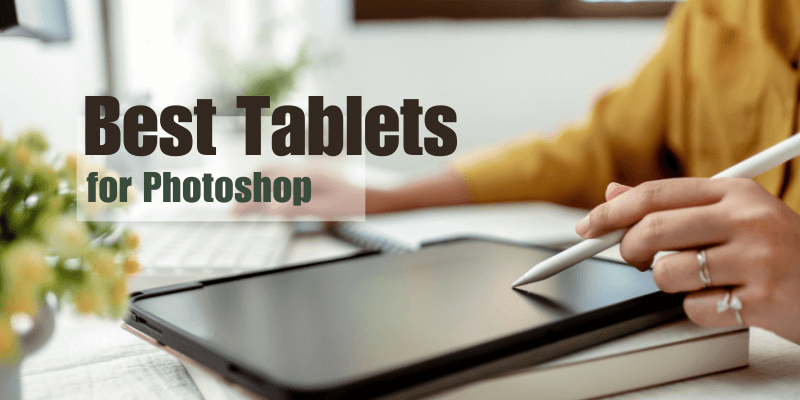As an Amazon Associate, I earn from qualifying purchases.
Using Photoshop on a portable tablet seemed like something out of science fiction only fifteen years ago, but there is now a wide range of tablets on the market that can handle it with ease.
While they won’t replace a desktop workstation for intensive Photoshop projects, tablets provide an unmatched combination of portability and tactile usability that can completely transform your editing workflow – and how much fun you have with it!
I’m a dedicated hardware nerd, from DIY homebrew projects to top-tier consumer electronics, and I’ve also been a Photoshop user for over 20 years. In case this is your first visit to the site, my name is Thomas Boldt, and it’s my job to keep track of every new piece of tech that can help with Photoshop so that you don’t have to.
I have been fascinated by the prospect of using a tablet for Photoshop ever since I saw the first Wacom Cintiq pen display way back in 2001. I’ve been closely following the evolution of the Photoshop tablet market ever since, and almost everything I dreamed it could be has come true – except for the infinite batteries. Maybe by 2031 😉
In this review, I’ll explain the most important features that you need in a Photoshop tablet, what makes them desirable, and highlight four different devices that meet a range of different needs. All the products I mention here are standalone devices that don’t require another computer to use, so you can experience the true portability offered by the tablet format.
Table of Contents
Key Takeaways
- To use the full version of Photoshop on a tablet, you need a tablet PC running Windows.
- iPads can run Photoshop for iPad, but it has fewer features than the full version of Photoshop.
- Android tablets can only use the ultra-basic Photoshop Express app, which makes them unsuitable for serious editing.
- The best overall tablet for Photoshop is the Huion Kamvas Studio 16, but the Wacom MobileStudio 16 is the best tablet for precision drawing in Photoshop.
How to Choose the Best Tablet for Photoshop
Using a tablet for digital image work can be a transformative experience, but only if you buy a tablet that can actually handle your workflow needs. The tablet device format also comes with some special considerations that aren’t normally part of buying a laptop or desktop computer for Photoshop, so let’s take a look at how you can choose the best tablet for your needs.
The Operating System
The first step in choosing the best tablet for Photoshop is deciding whether you want to use a tablet PC running Windows or a tablet that uses a mobile device operating system like Android or iPadOS.
Tablet PCs are typically priced more like laptops (read: expensive), but they also allow you to run the full desktop version of Photoshop, which is a significant advantage for serious Photoshop editors.
All of Apple’s tablets are limited to using a mobile version of Photoshop designed for the iPad, which is a promising new app that is currently under active development from Adobe, but it’s still lacking some key features that most serious editors will need.
Android users are stuck with Photoshop Express, which is yet another distinct version of ‘Photoshop’ intended for use with smartphone photography, but it only counts as Photoshop because of Adobe’s branding choices. Comparing Photoshop Express to Photoshop is like comparing a backyard model rocket to the SpaceX Falcon 9: technically, they’re both rockets, but only one of them can do any serious work.
Unfortunately, this makes Android a bad choice for a Photoshop tablet, so I won’t be highlighting any of them as good options.
The Stylus
The whole point of using a tablet for Photoshop is to combine the tactile editing experience of a graphics tablet with the ability to work directly on a touchscreen, so the stylus that pairs with each tablet is crucial to an enjoyable and productive Photoshop experience.
The sensitivity of your stylus will make a big difference in how responsive it is and how much it feels like working with physical media. A good tablet should be able to detect the angle of the stylus for more precise control over digital Photoshop brushes, and the best ones can detect over 8000 distinct pressure levels.
Unfortunately, some manufacturers (looking at you, Microsoft and Apple!) have decided not to include a stylus with their tablets, which means an added expense for those of you who want to use the full capabilities of Photoshop. You could always just use your finger instead, but I don’t recommend it.
The Screen
A good screen is essential for serious Photoshop editing since the screen on a tablet is both your viewing monitor and your work surface. It has to interface smoothly with your pen/stylus, so many of the best tablets for Photoshop use a matte screen surface with additional texturing added to make the drawing experience feel a bit more like traditional physical media instead of a slick glass surface.
A good screen should display the full sRGB colorspace that is standard for digital imagery. A great screen will also display the full AdobeRGB colorspace, in case you want to use your tablet for editing photos that will be used in high-quality printing.
Resolution is also a consideration, but since most tablets use a fairly small screen size, you may be comfortable with a lower resolution like 2560 x 1440, known as QHD, instead of 4K / UHD, which uses 3840 x 2160. There are also added benefits for battery life when using a lower-resolution screen since the GPU doesn’t have to pump out quite as many pixels per second.
The Hardware Specs
You’re never going to get a desktop workstation level of performance when you’re using Photoshop on a tablet, but it’s still important to have some capable hardware running the show behind the scenes. Your tablet’s CPU, RAM, and storage device will have a big impact on how smoothly Photoshop runs and how quickly it completes your tasks.
A recent Intel Core i7 chip will make short work of most Photoshop workflows while still providing decent battery life, and 16 GB of RAM should be considered the minimum for a good tablet experience.
A fast storage drive that uses the PCIe interface will speed up your file loading and scratch disk speed. 512 GB should be considered the minimum size you choose, but drives with at least 1 TB are preferable, especially if your tablet will act as your main Photoshop device.
A discrete graphics card will also help take some of the load off the CPU, but beyond a certain point, the GPU isn’t a huge performance factor for most Photoshop workflows.
The Battery Life
No matter what hardware specs you choose, they always have to balance out against your tablet’s battery. Faster hardware typically uses more power, which means shorter battery life. You can always just plug in your tablet while you work in Photoshop, but tying yourself to a power outlet removes some of the advantages of using a portable tablet workstation.
A good tablet will be able to balance smooth operation with a decent battery life of at least 5 working hours, and ideally, it will have a quick charging system to give you minimal interruptions during longer projects.
Keep in mind that when manufacturers make claims about battery life, they use very specific testing conditions to make their devices look their best, so your experience may vary a bit. It can be very hard to predict battery life since it depends heavily on how you’re using Photoshop, what other apps you’re running in the background, and even which tools you’re using in Photoshop.
The Add-on Features
There are always a few extra touches that can make a big improvement in your tablet’s ease of use with Photoshop:
- Tablets don’t always have a keyboard available to complement your stylus input, so a few extra buttons placed around the frame can be a major advantage.
- An integrated stand can also give you added flexibility in your workspace setup.
- Weight is always a consideration for portable machines since some of these devices are heavy by modern laptop standards.
The 4 Best Tablets for Photoshop Reviewed
Now that you know what makes a tablet ideal for Photoshop work, it’s time to look at some of the best tablets available for Photoshop artists.
Best Overall Tablet for Photoshop: Huion Kamvas Studio 16
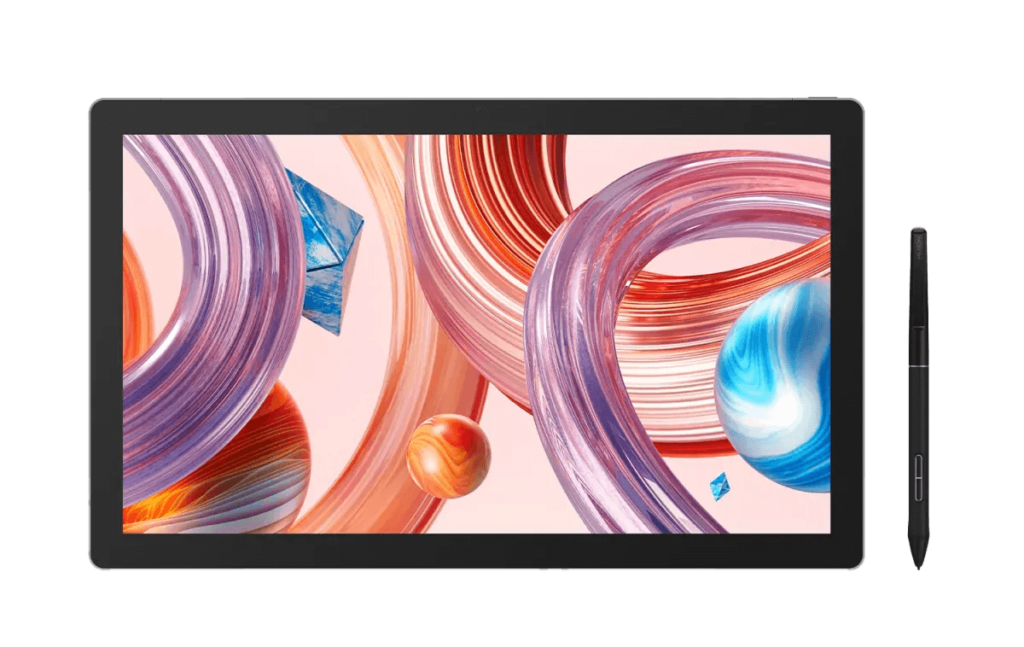
- OS: Windows 11 Pro
- Pen / Stylus: PW550S PenTech 3.0, battery-free, included with purchase
- Screen: 15.8” matte screen, 2560 x 1440 resolution, 100% sRGB coverage, 100% Adobe RGB coverage
- Hardware Specs: Intel i7-1165G7, 16GB RAM, 512 GB SSD, Iris XE graphics card,
- Battery Life: 5-6 hours of usage, according to Huion
The Kamvas Studio 16 is the most recent Photoshop tablet on the list, and it shows. A beautiful matte screen displays the full sRGB and AdobeRGB colorspaces, although the QHD resolution is the lowest of the tablets on this list. The PenTech 3.0 stylus system provides an excellent drawing experience with over 8000 pressure sensitivity levels and stylus tilt detection.
The recent i7-1165G7 mobile processor provides a good balance of speed and battery conservation, and 16 GB of RAM provides a decent amount of working headroom for high-resolution files, although you will start running into issues when running too many other apps in the background in addition to Photoshop.
Huion doesn’t specify what speed their SSD runs at or which connection interface it uses, and haven’t responded to my request for details as of this publication date, but I’ll update the article when I get a response.
At 3.7 lbs, this is not exactly a lightweight machine, but it’s still a whole pound lighter than the Wacom Mobile Studio, and it’s also significantly cheaper for similar processing performance.
The TDLR summary: Huion Kamvas Studio 16 is the best choice for most Photoshop artists, and especially for those who need full coverage of the AdobeRGB colorspace.
Best Tablet for Drawing in Photoshop: Wacom Mobile Studio 16
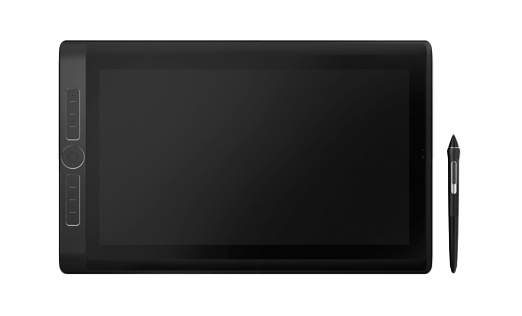
- OS: Windows 10 Pro
- Pen / Stylus: Wacom Pro Pen 2, battery-free, included with purchase
- Screen: 15.6” matte textured screen, 3840 x 2160 resolution, 100% sRGB coverage, 85% Adobe RGB coverage
- Hardware Specs: Intel i7-8559U, 16GB RAM, 512 GB SSD, Nvidia Quadro P1000 graphics card
- Battery Life: 5 hours of “average battery life” according to Wacom
Wacom is widely regarded as one of the most reliable manufacturers of touch-based input devices for Photoshop, and they’ve created a masterpiece for Photoshop artists with the Mobile Studio line. The screen is a spacious 16 inches with a matte textured finish for an excellent tactile feel, and its bright 4K resolution
The hardware specs for the Wacom Mobile Studio are getting a bit dated now, but there’s no word on when (or if) we’ll see a new version of the tablet. The Intel i7-8559U processor paired with 16 GB of RAM is perfectly capable of running Photoshop, but you may want to limit your use of background apps to keep Photoshop running smoothly with no input lag.
Because the Wacom MobileStudio has a discrete Quadro P1000 workstation graphics card instead of using the integrated graphics provided by the i7-8559U processor, it’s a bit heavier and bulkier than most of the other tablets on the list, which also makes it less portable. However, Wacom has made good use of this extra size by including some extra input buttons on the left side of the screen, although this may not be quite as appealing to left-handed artists.
Note: You may be able to upgrade the OS to Windows 11 for free, but Microsoft has changed the Windows 11 system requirements in the past, so this may no longer be possible.
The TDLR summary: Wacom Mobile Studio 16 is the best choice for those who care about extreme precision in their stylus input.
Best 2-in-1 Tablet for Photoshop: Microsoft Surface Laptop Studio
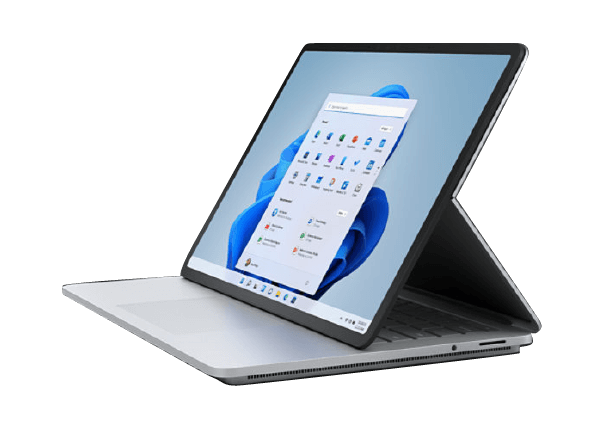
- OS: Windows 11 Home
- Pen / Stylus: Surface Slim Pen 2, rechargeable, sold separately
- Screen: 14.4” PixelFlow Sense screen, 2400 x 1600 resolution, 100% sRGB coverage
- Hardware Specs: Intel i7-11700H, 32 GB RAM, 1TB SSD, Nvidia RTX 3060 Ti graphics card
- Battery Life: 5-6 hours of heavy usage, more with lighter usage
As you probably guessed from the name and category, the Surface Laptop Studio combines a tablet-style touchscreen with an attached keyboard like a laptop. This positions it perfectly for Photoshop users who occasionally want the tablet drawing experience without having to carry around a second device for more typical office productivity workflows.
Microsoft is a bit unspecific about how sensitive the Surface Slim Pen is, and it’s also sold separately from the device, so be prepared for that added cost. Fortunately, the hardware in the Surface is the most capable on the list, combining a recent i7 processor with a spacious 32GB of RAM and a fast 1 TB storage drive. The RTX 3060 Ti has 4 GB of dedicated video memory, allowing it to handle most GPU-accelerated Photoshop tasks with ease.
Unsurprisingly, the 2-in-1 tablet/laptop form factor makes this the heaviest device on the list at 5.92 lbs, but it’s also the most powerful, so you’ll have to decide if the power/portability trade-off is worth it for you.
The TDLR summary: The Surface Laptop Studio is best for users who want the tactile experience of Photoshop on a tablet but also the ability to function as a laptop for non-Photoshop work.
Best Apple Tablet for Photoshop: iPad Pro 12.9” (M2 Edition)
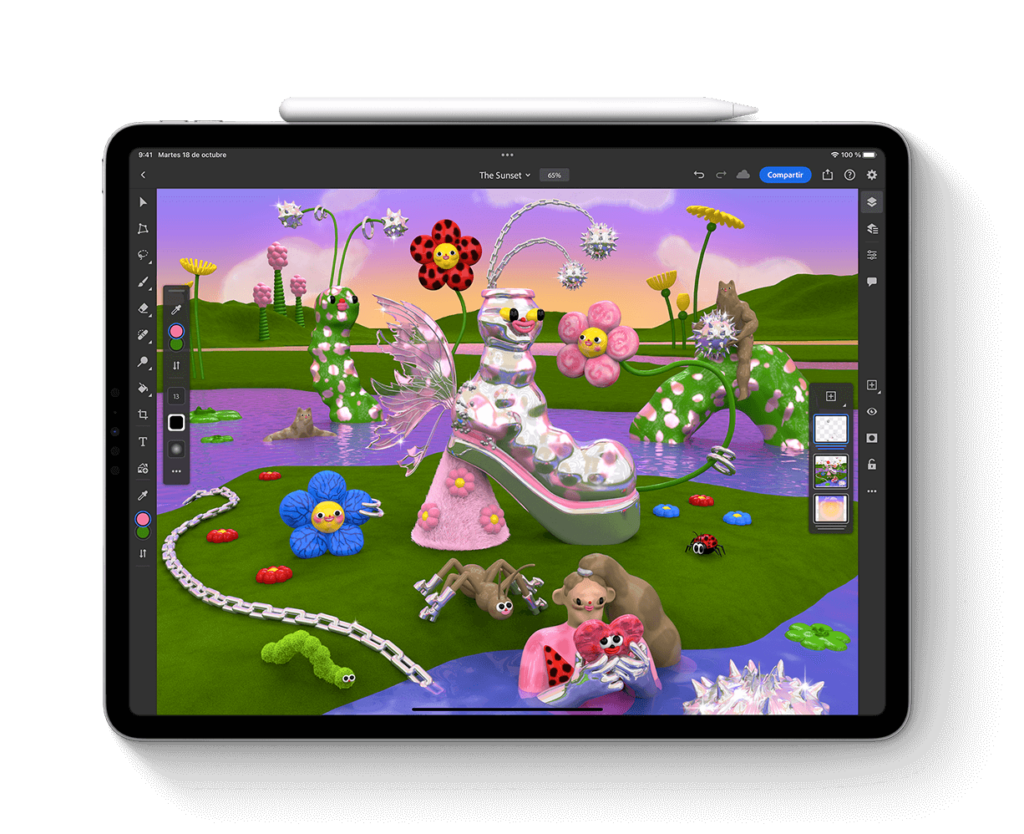
- OS: iPadOS
- Pen / Stylus: Apple Pencil / Apple Pencil 2, rechargeable, sold separately
- Screen: Liquid Retina XDR, 100% sRGB coverage
- Hardware Specs: Apple Silicon M2 with 10-core GPU, 16 GB RAM, 1 TB storage space
- Battery Life: 10 hours of video playback, Photoshop time will depend on usage.
Many people recommend the iPad Pro as the best tablet for Photoshop, but despite having comparable hardware, it has a number of drawbacks compared to the other tablets on this list. The biggest issue is that it runs iPadOS instead of macOS, and the only compatible version of Photoshop is a limited mobile version designed specifically for the iPad.
That being said, if you don’t need to use the full desktop version of Photoshop, the M2 iPad Pro is an excellent tablet. The M2 chip is the most recent processor found in my selected tablets list, and it enables some neat stylus tricks like input hovering that aren’t available on the other devices, although I’m not sure how useful that will be for every Photoshop artist.
As long as you select the model with 1TB of storage space, the iPad Pro comes with 16GB of RAM for all your editing needs, although this drops down to 8GB when selecting a smaller storage capacity, although the hardware requirements for the mobile version of Photoshop aren’t quite as demanding.
Since it’s not trying to compete with the laptop/desktop market, the iPad Pro has the distinction of being the lightest and cheapest device on this list, which is something of a rarity for Apple products.
The TDLR summary: The M2 iPad Pro is the best choice for dedicated Apple users who don’t mind working with the limited mobile version of Photoshop.
Frequently Asked Questions
Using Photoshop on a tablet is still a relatively new possibility, so even some experienced Photoshop users have some questions about how it all works. I’ve collected a few of the most common questions that get asked about using tablets for Photoshop, but if you have a question that isn’t listed here, let me know in the comments below, and I’ll try to help.
Can Photoshop work on a tablet?
Yes, Photoshop can work on a tablet, but only tablet PCs that use Windows can run the full desktop version of Photoshop. You can also technically use Photoshop on the full range of Apple iPads, but you have to use an iPadOS-specific version called Photoshop for iPad, which has limited functionality compared to the full desktop version. Fortunately, Photoshop for iPad is included in all Photoshop subscriptions at no extra charge.
Which tablet is best for Photoshop and Illustrator?
The best way to use Photoshop and Illustrator on a tablet is by using a tablet PC running Windows since you can use the full desktop versions of both apps. Adobe has also created new versions of Photoshop and Illustrator for use on Apple iPads, but they’re not as powerful as the full desktop versions. The best overall tablet, the best tablet for drawing, and the best 2-in-1 tablet that I have selected below can all run Photoshop and Illustrator.
Can I install Photoshop on an Android tablet?
You cannot install the full version of Photoshop on an Android tablet, and there is no special version of Photoshop made for Android tablets the way there is for iPadOS. You can install a free app from Adobe known as Photoshop Express, but it’s in a whole different universe from the desktop version of Photoshop, and it’s also far less capable than Photoshop for iPad.
A Final Word
The standalone tablet computer format is one of the most exciting developments in Photoshop since the first drawing tablet, and it can completely revolutionize your entire workflow. Take a close look at how you want to use Photoshop and one of the tablets mentioned above will enable you to achieve all your tactile input dreams.
Happy drawing!
About Thomas Boldt